In a Nutshell: The Mausoleum, otherwise known to locals as the Kumsusan Palace of the Sun is the final resting place of North Korean leaders Eternal President Kim Il-Sung and Supreme Leader Kim Jong-Il. Their bodies are displayed inside for public viewing within climate-controlled clear glass sarcophagi. Here’s what it’s like to visit.
Afront the hotel wall mirror I straighten my tie, tuck in my cotton shirt and give my dress shoes one final shine. It was early morning in Pyongyang, North Korean State Television had jump-started my day — militaristic musical odes to Kim Il-Sung and censored news broadcasts followed by Kim Jong-Il looking at things with approval. Moments later I was heading to the capitals outskirts with five state-sanctioned guides on one of the most ‘important’ visitations of my life. Oddly, to visit these two aforementioned gentlemen in the flesh. Whom may I add, also died 4 and 21 years ago respectively. Welcome to another day in North Korea.
It had all the hallmarks of a job interview, only it wasn’t — the strict formal attire, designated time slot and an expectation of pseudo-passion for a topic I knew relatively little about. Even my professionalism was to be critically judged. Quite the task to uphold after a late night prior sinking marinated Snake Soju in the Yangakkdo Hotel’s karaoke bar. There was a feeling of uneasiness, almost nervousness too, if I’m honest. The reality was, today’s importance wasn’t derived from potential employment, but from the prospective lifetime detention I’d face if I didn’t so much as bow when required. Something I paid good money for, by the way. Goodness, writing it out really puts it into perspective.

The destination, known simply as ‘The Mausoleum’ to outsiders is the most holy building in North Korea – an otherwise atheist nation. Inside, the embalmed bodies of Eternal President Kim Il-Sung and as of 2011, his son Supreme Leader Kim Jong-Il lie in state inside climate-controlled clear glass sarcophagi for your viewing pleasure. They’re surrounded by mazed marble hallways, each a trove of their life’s treasures and accomplishments. Eyes peer at you from every corner. Cameras. Guards. Access is from an underground tunnel hundreds of metres away. In many ways, a leaf has been taken from Egypt’s book of pyramid interior design. The unmistakeable stock portraits of each, representative of what feels like every street corner of Pyongyang, hang defiantly on the restricted walls outside, where each visitor must bow to their likeness.
Really, this building is no joke. One of biblical proportions surrounded by laws ironically denouncing religion as punishable by death. Juche; a political ideology of self-reliance with religious undertones is the flavour of North Korea’s belief system, practiced by all North Korean citizens. Not by choice. Kim Il-Sung coined the ideology, originally as ‘Kimilsung-ism’ (seriously) and hence, retains the throne as the demi-god to all ‘believers’. The Jerusalem, Mecca, Temple Mount – whatever, this building is the equivalent, romanticised to locals only as the Kumsusan Palace of the Sun.
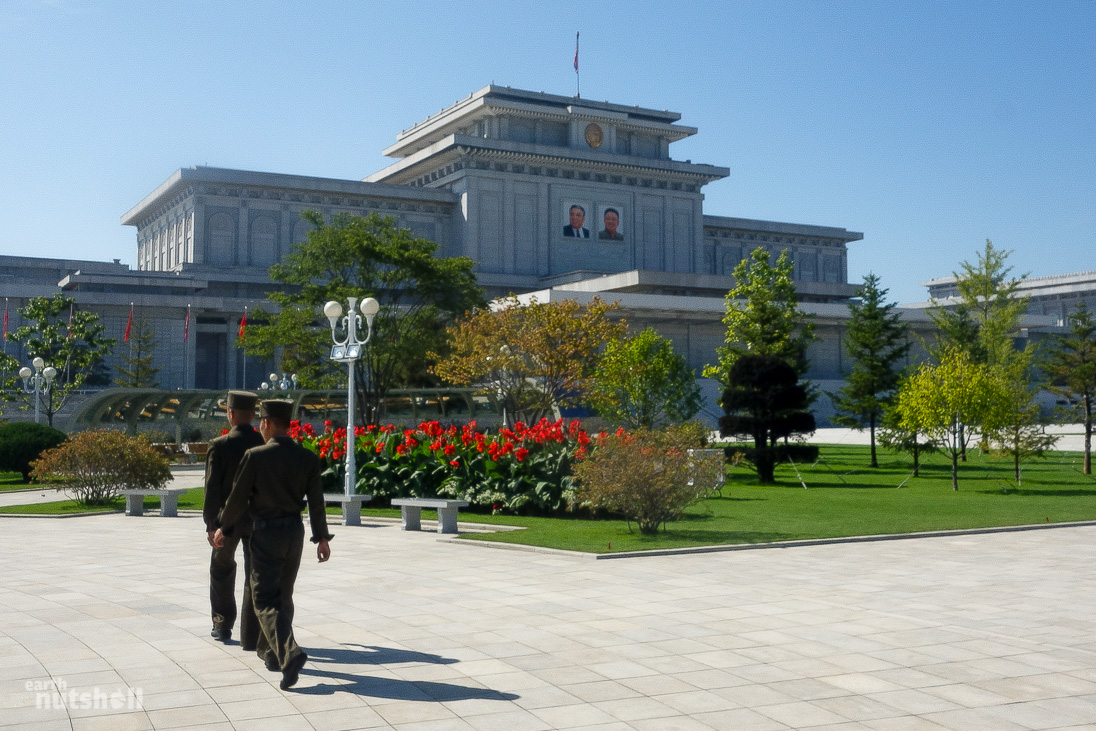
Our guides lined us single file prior to entry, offering a rundown on proceedings ahead and etiquette required. Absolutely no speaking, stand straight with hands to your sides, remain in line and always bow when required. So, together we marched forwards into this misplaced extravagance like baby chicks closely behind mother hen in a way that took me back to childhood scouts camp.
First came the ‘cloak room’, all belongings aside from the shirts on our backs were handed to the ladies here in place of a numbered ticket for collection when we were to leave. Unfortunately, this is the part where I break the news to you that this absolutely included cameras, hence neither I, nor anybody else have photos from within these secretive walls. To ensure we weren’t crazy enough to pull a swift one in the most formal house of exemplary, ruthless communist rule, a metal detector was conveniently placed to our right to uncover any secrets. A tough place for a selfie. Sorry guys, it just wasn’t possible.
Curiously, local North Korean visitors had further security screening. This included what appeared to be their photo taken and iris scanning before being whisked out a different door. Who knows? We endured some fancy automated shoe cleaners before being released into a spotlessly polished white marble hall stretching as far as the eye could see.

Here, we begin our journey into the palace. Let me set the scene for you:
One kilometre of travelator, movement speed: Snail. No walking allowed. Glorious, orchestral music of Great Korea. Hundreds upon hundreds of large, gold framed photographs straight out of Bowser’s Castle on Super Mario 64 lined the walls. Each photograph depicts foreign relations and domestic press release snaps of either Kim Il-Sung or Kim Jong-Il. Hand shakes accompanied by ear-to-ear grins. Think Castro, Ghadaffi, Mao, Stalin, Putin, Ho Chi Minh…U.S president Jimmy Carter. They’re all there. One big happy family. The atmosphere was surreal, one that tied perfectly into my initial North Korean expectations.
The travelator took at least twenty minutes, if not more. Of course, this was no accident — a time to mourn, reflecting upon the lives of two men who made the North Korean Dream a reality for all. Meanwhile, a glance outside the adjacent window nearing the palace revealed at least 15 ‘privileged’ women from Pyongyang’s working class gardening a single grass patch simultaneously with makeshift brooms constructed from sticks.
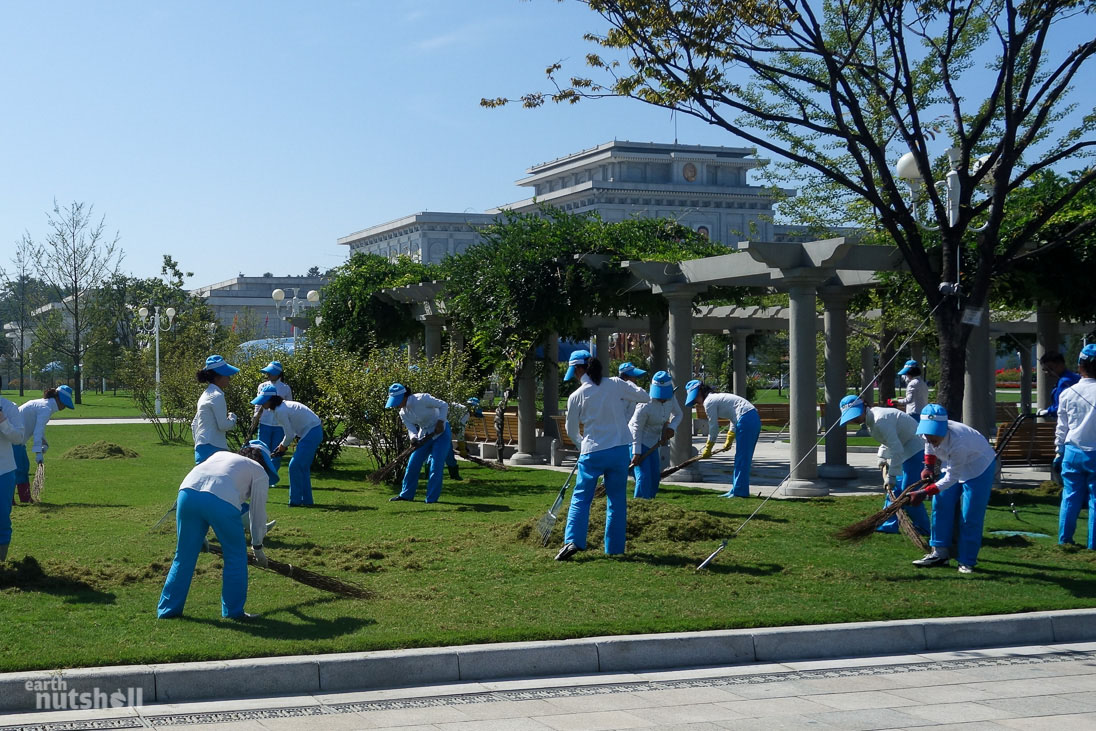
Ushers direct our path into the palace, where ceremonious flowers are presented at the feet of two giant white marble statues of both leaders. The room was dim, tall, and spacious; like a church hall, where even the silence would echo. Dramatic red light presented each sculpture, a representation of North Korea’s national shade. Korean People’s Army officials stand to each side, separated by Korean Worker’s Party flags and brandishing silver AK47’s. We synchronously bow at the designated line.
Originally, this building was Kim Il-Sung’s official residence, in many ways The White House. Eventually, it was transformed into his final resting place by Kim Jong-Il after his father’s death in 1994. It was estimated at a staggering $500-$900 million USD renovation – quite the cost; coincidently during this year until 1998, North Korea endured its worst famine in history where up to 3.5 million died from starvation or hunger-related illnesses as state allocated rations dropped to 20% of what the Worlds Food Program describes as a ‘survival ration’. Read into that what you wish.
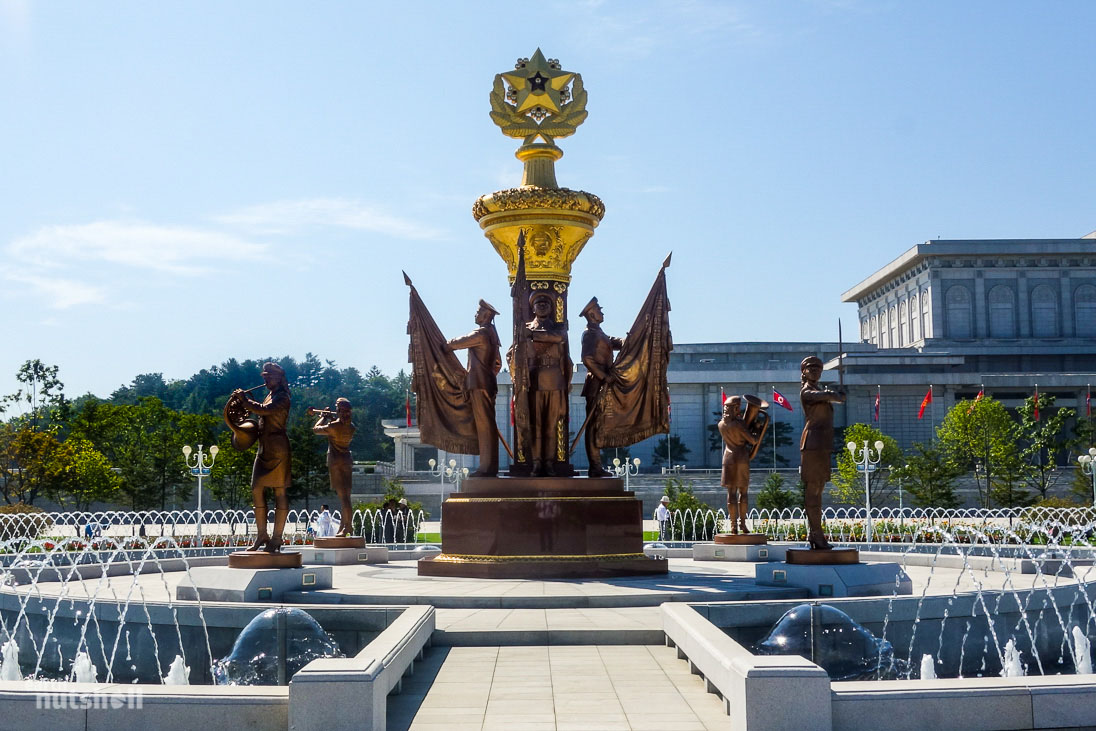
A lift akin to New York’s Hilton Hotel then ascended us to the waiting room preceding Kim Il-Sung’s Mausoleum.
Men dressed in black, equivalent to the United States Secret Service were on every corner and doorway to the room. Each had concealed pistols in holsters, marking the only time I saw officials like this in the country. It was quite loud on this floor and we quickly discovered why – enormous air blowers had been installed to take every speck of dust from our attire. For a moment there, I almost felt like a plastic bag…drifting through the wind…(mistimed The Interview reference, sorry). But by all measures, so much for my perfectly styled buzzcut.
We regrouped and on our guides’ direction were eventually allowed inside.
The room was dark, a curtained space of marble floor and wall, dimmed in red lighting with spotlight to the centre on the room.
And there he was. The man himself. Eternal President Kim Il-Sung.
Lying on a tabletop inside the crystal glass sarcophagus as promised lay his lifeless body of the last 21 years. That’s a long time, dead and preserved long enough to be of legal drinking age in Arizona. Perspective. His body was draped in the red flag of the Workers’ Party of Korea, upper torso visible in dark suit jacket and his shiny, almost waxxy head angled upwards by a pillow. Madame Tussauds would be proud. To be honest, he looked a little too well-preserved – although one of my guides did mention the Mausoleum undergoes closure some months of the year for, well, corpse maintenance. Surrounding his casing were downward sloping beds of flowers. Not just any flower mind you, but the fabled pink Kimilsungia. I’m not making this up.
Our line, now filled with local visitors donning their leader’s head pinned upon their heart advance forward, molding into groups of 4 at the front to show respects to Dear Leader.
Now, this is one of the times where if you declined the opportunity – you’d be arrested on the spot for political crimes. Korean People’s Army officials watch on from the room’s outskirts, as each group approaches Kim Il-Sung to bow. Not once, but three times. Once at the feet, once on the left and once on the right – but absolutely not at the head. As of course, that would allude to looking down upon the man representative of the peak of greatness.
I was quite relieved such a simple expectation was over with. As we exit, another tourist and I exchanged gazes as if to say ‘Well, yep, he’s certainly dead – I don’t know what else I was expecting’. It was a strange visit.
But, of course this is North Korea and it got stranger.
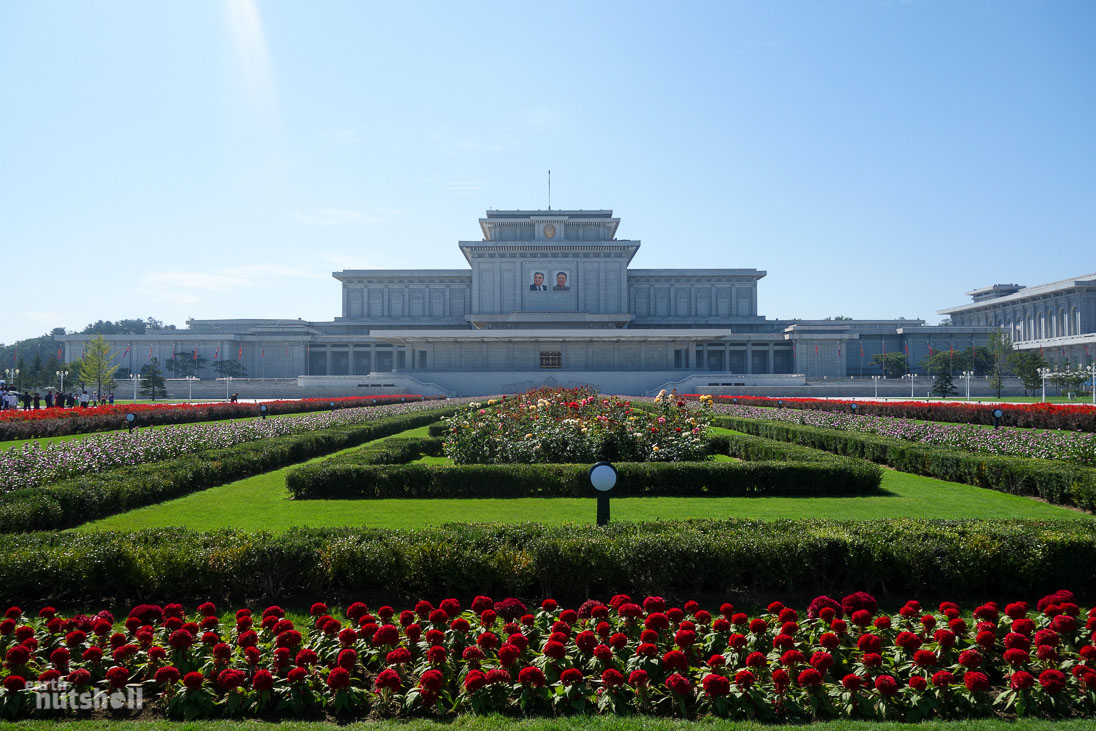
The following number of rooms were laid out as shrines, linear walk-throughs with hundreds, if not thousands of Kim Il-Sung’s “achievements” — medals, certificates, plaques and trophies. I use quotes here, because the legitimacy of many could be questioned at best and were straight up fraudulent at worst. Most were from within North Korea, however certain display cabinets were sectioned for each continent. Every democratic country was represented, as were private international enterprises (tsk tsk). To expand, there was a PhD certification from Kensington University in California — upon closer inspection, a for-profit unaccredited diploma mill since closed by authorities. ‘Keys to the city’ were given and displayed proudly to an obscure district within a small province of the Cusco region of Peru’s Southern Highlands. The ‘Peace Award’ of Africa was showcased — a large trophy, as was the ‘Honorary Citizenship of Ecuador’. There was even an award for ‘peace, justice and humanity’ exhibited with pride from an Indonesian foundation. Scholarly robes were hung, encased in glass aside all his educational accreditations.
It was absolutely bizarre. The focus on perceived international importance was certainly evident here – most ironic considering the enforced boycott of the outside world.
Countless medals sat inside open velvet casings laden in silk, illuminated by bright light — Hero of the Republic, Hero of Labour, Medal of Agriculture Merits, Military Service Honour and commemorative items of the Great Fatherland Liberation War. The list went on. The medal ‘For The Victory Over Japan’ lay next to the Japanese Peace Medal. Poetic. Alike the robes, military uniforms were also encased in glass beside these medals.
Kim Jong-Il’s achievement room was similar, he notably received the International Kim Il-Sung Prize Certificate, awarded for (and this is the exact wording): …the distinguished contribution to the sacred cause of independence and peace on the globe through application of the great Juche idea. Round of applause, Kim.
Kim Jong-Il’s mausoleum was likewise almost exactly as his fathers’, with the same formal entry process including another air blower – I’ll save you the detail. However I will mention that he wasn’t wearing his signature sunglasses (I was actually surprised), he was outfitted in that darn olive zip-up suit he wore literally everywhere and he looked as if he’d just had a fresh haircut. He didn’t look more or less dead than his father. Well, that was a weird sentence to type. Anyway, oh, and of course he wasn’t surrounded by Kimilsungilia’s. Don’t be silly. It was the red Kimjongilia instead. Once again, not making this up.

At this point we expected that to be a wrap. We’d paid our respects and been reminded of all the fascinating accomplishments. But wait, there’s more. Just like a 4am infomercial.
North Korea have an unhealthy obsession with preserving sentimental items. Items used or even touched by the leaders become in many ways holy. Chairs sat upon, stationary used and even areas Kim Jong-Il had walked are regularly engraved with a red ‘X’. So, what happens to Kim Jong-Il and his father’s major belongings after death?
How about, for example his…Yacht?
Yep, it’s here. In the building. They had to temporarily knock down a wall, but they got it inside. It’s surrounded by framed photographs of Kim Jong-Il enjoying life aboard, the room’s walls are engraved in gold Korean Hangul of the boats history. Each owned a Mercedes too which is on display, as is Kim Jong-Il’s golf cart used in his later years – all of which are propped up on marble blocks, roped off like a luxury car sales showroom.
But Kim Jong-Il’s private train takes the cake. The very carriage he died inside from a suspected heart attack sits within a custom built room, interactive boards on the walls show in intricate detail all the locations worldwide the train had visited. He was afraid of flying.
One of the guides explained – “Supreme Leader Kim Jong-Il died of overwork, he was under great mental and physical strain, it was sudden and the train here is exactly as he left it.”
Peering into his private life through the train window, there was a 17” Macbook Pro on his desk. I can’t say I expected that. Well, this settles it ladies and gents, Macs are better than PC. Paper is sprawled over his final workspace without overlap, his boots perfectly straightened and his seat faced us photogenically as if for a real-estate shoot. His living space was clean. Very clean — unlike any man I’ve known!
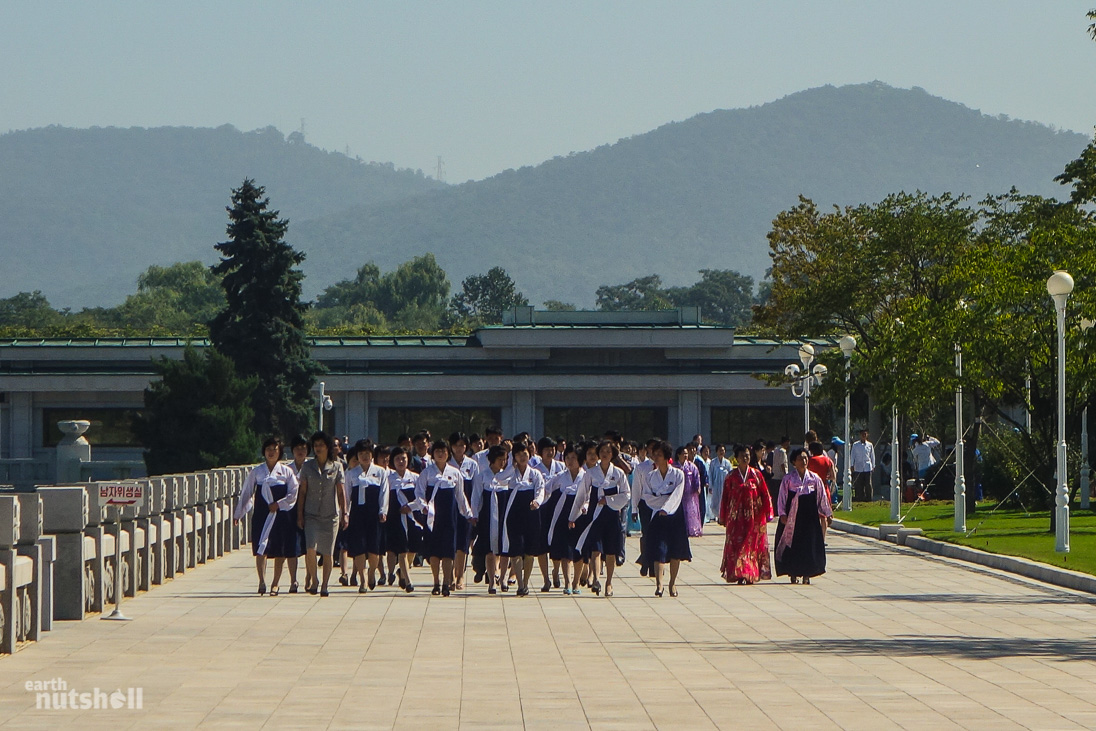
We began to exit the palace the same way we entered, passing hundreds of North Korean civilians arriving for their mandatory visitation. Every citizen must visit at least once by law — men, women and children. Those from rural areas were obvious, faces of malnourishment dressed in silk suit jackets on bare sun-blazoned skin. Many smiled at us as they shuffled past. Most were only as tall as my shoulder, and I’m not a large bloke.
Our last stop was one that appropriately summed up the visit, an impact statement to us on the effect of the Eternal Presidents death worldwide. This was the Hall of Lamentation. An empty room with a single red rug and beautiful low hanging chandeliers, the walls containing framed depictions of North Korean and international outpourings of grief during the 10 day state endorsed ‘mourning period’ following that unforgettable news. It’s almost as if they’ve something to prove.
We bow one last time and finally, we left the Kumsusan Palace of the Sun.
Wow.
That was my reaction. I don’t think any other word could sum it up. I wanted North Korea and well, I got North Korea in this visit.
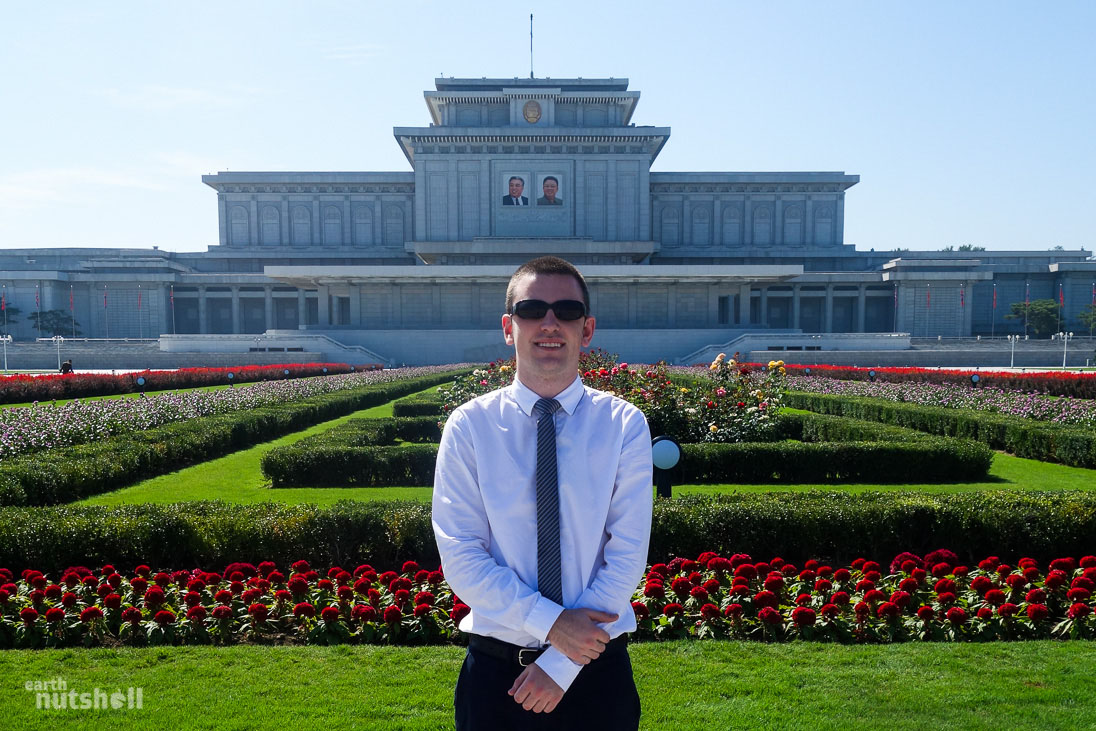
In a country infamous to outsiders for decades of human rights violations, those responsible are truly held up as demi-gods here, serving instead as inspiration to a population oblivious to their own misfortune. This was clear. And, it was real. The endearment and heartache for these fallen leaders was authentic. The Kumsusan Palace of the Sun is by all accounts a perfectly choreographed propaganda art piece of indoctrinated North Korean faith — what to believe, how to believe and when to believe it. There is no freedom of knowledge, citizens know no other, Kim Il-Sung and Kim Jong-Il have long been their only providers. They’ve put the food on their table, built their homes, given them jobs and led the homeland to patriotic ‘victory’ against invaders.
Here, in this palace they give their thanks.
Don’t bite the hand that feeds you, it couldn’t be more literal and relevant — the fundamental issue of which is being unawares of how little the hand is feeding.
What a fascinating visit.
We strolled through the Mausoleum grounds afterwards, swans resting peacefully in the surrounding moat. There was a pervasive feeling of confusion among us with the atmosphere similar to that of a post-funeral reception. We were hesitant to bring cheer back into the situation so soon around our passionate guides.
As we leave, others arrive destined for the same exhausting induction — lines of school children march past us in formation, wide-eyed and entrusting in their school teacher, leading them similar to that of the pied piper. They were innocent, still learning the ropes to life; only yet a basic grasp of expectations and values, responsibilities and purpose, rights and wrongs — no different to young children anywhere else in the world.
Seconds later I look back to see them stopped, assembling together for a professional photograph to a backdrop unlike anywhere else in this world.
The next generation.
P.S – What are your thoughts on the Mausoleum and it’s purpose? Do you believe the North Korean people are truly indoctrinated, or governed by fear? Let me know in the comments below! Cheers, Elliott.
Interested in North Korea? More coming soon! Follow me on Facebook!
The post Dead Presidents in North Korea – The Mausoleum appeared first on Earth Nutshell.

